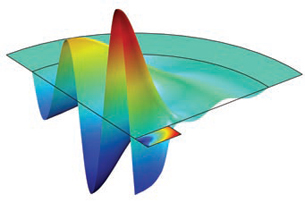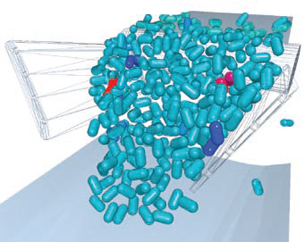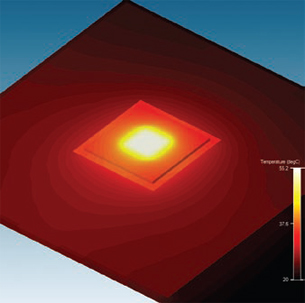Latest News
December 1, 2008
By Pamela J. Waterman
« Page 1 | 2
 COMSOL Multiphysics analysis of a MEMS piezoelectric transducer. Shown are the near field and far field pressure levels of acoustic waves. Image courtesy COMSOL |
Mapping Demanding Flow Behavior
CD-adapco has years of experience with analyzing fluid-flow, thermal, and stress applications in the automotive industry. In addition to its more general-purpose packages such as STAR-CCM+, the company offers a family of products (called expert solutions or es) for a variety of applications, including the design of internal combustion engines (ICE). The software builds on the company’s first ICE consulting project for Renault in 1990, which led to the development of expert systems that clients could run for themselves.
One targeted product is es-ice (expert solution-internal combustion engine), which enables engine designers to automatically generate the complete mesh motion for an in-cylinder calculation. This process now takes only a few days, compared to the traditional model setup and runtime of more than several weeks. Users can increase the complexity of the model by automatically going from a single cylinder to multiple cylinders. When combined with the moving-mesh models and physics modeling of the STAR-CD solver, users can readily account for turbulence, heat transfer, spray nozzle flow, droplet dispersal, ignition, combustion, and pollutant emissions, all in one system.
When is a niche-sounding analysis package actually widespread in its use? Answer: when that package is Barracuda from CPFD Software. Nylon manufacture, coal processing, paint-pigment mixing, and gasoline production in “cat crackers” are just four of the many industries that need to analyze granular flow in a gas or liquid. Barracuda incorporates the correct physics of the movement of solid particles together with transporting fluids, based on computational particle-fluid dynamics (CPFD).
Barracuda can model a wide range of fully coupled fluid-particle-thermal industrial systems, including coal gasification and the complex mixing and reacting processes within fluidized-bed reactors. In the latter, a stream of air or gas passes upward through a layer (or bed) of solid particles — whether chemicals or coffee beans — with a rate of flow sufficient to set the particles in motion. The software calculates gas/solid distributions for mixtures with more than 5 million particles, yet can run complex 3D problems for several minutes of real-time operation within days. The package runs on Linux systems.
 EDEM discrete element modeling software simulates the tumbling flow of pills in a conveyor system, allowing visualization of momentum, heat, and mass transfer. The multiphysics software can track the multimillion particle flow of granular solids with non-spherical shapes, including mixtures of shapes, and model particle-wall interactions. Image courtesy DEM Solutions |
DEM Solutions is another software company that works in the world of particles. It has developed a discrete element modeling (DEM) package that simulates the behavior of both particles and the equipment with which it interacts. The company’s EDEM software is based on a meshless technique: it only needs surfaces to operate on, then tracks when particles hit each other or that surface. It can take into account mass, temperature, velocity, and even shape for each particle, and can be coupled with CFD software. The package runs on Windows and Linux, and comprises a preprocessor, solver, and postpocessor — all with a common GUI.
One of DEM Solutions’ major application areas is pharmaceutical production. It is generally acknowledged that many pharmaceutical processes are inefficient and poorly understood. Quality assurance through inspection rather than design has been the norm, but recent legislation is forcing organizations to build quality in first. EDEM can simulate and promote understanding of such relevant milling and mixing functions as controlling particle size, minimizing contamination, assessing impact forces on equipment wear, guaranteeing mixing profiles, and identifying segregation rates for different fill levels, speeds, and loads. All of this information helps prevent dosage variations, control quality, reduce waste, and minimize equipment wear. EDEM users can build libraries of such parameters specific to their processes.
But Wait, There’s More
If you operate in the cosmically tiny world of microelectromechanical systems (MEMS) devices, you might want to work with the MEMS Module from COMSOL designed for use with COMSOL Multiphysics software. The MEMS Module adds MEMS specific terminology and methods for easy setup and solution of physics phenomena on a microscale. Predefined interfaces are available for solving problems involving structural mechanics, large deformations, electrostatics, piezoelectricity, and microfluidics. The software can also deal with such multiphysics effects as fluid-structure interaction, electro-thermal interaction, and thermal-structural interaction.
The COMSOL targeted tool is helpful in the design of such devices as MEMS resonators, microrobots, and bioMEMS sensors. The MEMS Module application also allows coupling to other phenomenon in COMSOL applications, such as pressure acoustics. For example, when a piezoelectric transducer is used to generate acoustic waves in a surrounding fluid medium, the software can calculate both the near- and far-field pressure levels.
 Thermal analysis results of IC packages obtained via web-based thermal characterization software FloTHERM.PACKSIM from Mentor Graphics Corp., Mechanical Analysis Division (formerly Flomerics). Images courtesy Mentor Graphics |
On a slightly larger scale, do you need to quickly examine the electrical behavior of ICs once they’ve been designed? ANSYS Icemax is customized every step of the way to do just that. Powered with the ANSYS FLUENT solver, Icemax uses finite volume field technology to analyze signal integrity, power integrity and switching noise on next-generation system-in-package designs. The software can handle many combinations of styles, including flipchip and bondwire designs, multi-die packing, and package-on-PCB structures, among others. It even knows whether bond wires are gold or copper.
Users can bring in files created in EDA platforms such as Cadence, or from standard Gerber data. Icemax will recognize the concepts of a net, trace, and via, and ask for the operating frequency. It then does an RLC extraction of the net, calculating resistance, inductance, and capacitance. The software automatically meshes the geometry, characterizes part or all of the package, and writes the output data in a format directly accepted by such circuit simulation software programs as SPICE and Nexxim (the latter is from the Ansoft product line which is now part of ANSYS).
Looking For Still More?
With a little searching, you’ll find even more products offering tailor-made solutions. If you focus on turbulent flow through such turbo-machinery as voltek or sirocco fans, consider the models in SC/Tetra, the finite-volume CFD software from Software Cradle. For electromagnetic field analysis of high-frequency, high-speed electronic components such as phased-array antennas, look to HFSS simulation software from ANSYS. And if you need to predict the structural behavior of a ship’s hull when cresting a wave, you may want to evaluate the Trident FEA analysis package from MARTEC.
Finding the right niche software just may make your day, week, and entire project. Check them out.
More Info:
ANSYS, Inc.
Canonsburg, PA
CD-adapco
London UK
COMSOL
Burlington, MA
CPFD Software, LLC
Albuquerque, NM
DEM Solutions, Inc.
Lebanon, NH
MARTE C Ltd
Halifax, NS, Canada
Mentor Graphics, Mechanical
Analysis Division (formerly Flomerics)
Marlborough, MA
Siemens PLM
Plano, TX
Software Cradle Co., Ltd.
Osaka, Japan &Dayton, OH
Contributing Editor Pamela J. Waterman is an electrical engineer and freelance technical writer based in Arizona. You can contact her about this article via e-mail sent to [email protected].
« Page 1 | 2
Subscribe to our FREE magazine, FREE email newsletters or both!
Latest News
About the Author
Pamela Waterman worked as Digital Engineering’s contributing editor for two decades. Contact her via .(JavaScript must be enabled to view this email address).
Follow DE





